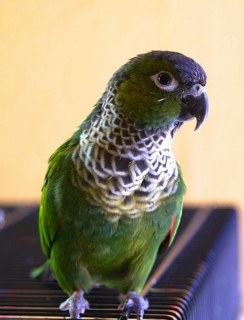Black-capped Conure |
|
|
Also known as: Black-capped Parakeet, Rock Conure
Photos
View in GalleryDid You Know?
The Black-capped Conure may breed in the wild with the Green-cheeked Conure, producing hybrids.Academic Research
Related publications: Pyrrhura rupicolaSpecies Profile
Genus: Pyrrhura | Species: rupicola
Size:
25cm (9.75 in)
Weight:
70g (2.45 oz)
Subspecies including nominate:
two: P.r. rupicola, P.r. sandiae
Colour Adult:
P.r. rupicola: Both adults black forehead to occiput; green cheeks, ear coverts and line above eye; black hindneck with off white scalloping to feathers; dark brown breast scalloped with off white; lower breast washed with dull yellow; red primary coverts and carpal edge; green tail. Bill black. Bare eye ring grey, eye brown.
P.r. sandiae: Both adults narrower off white scalloping to feathers of neck and breast; on hindneck almost none.
Colour Juvenile:
As in adults but duller; green primary coverts and carpal edge. Cere and bare eye ring white.
Call:
Calls made in flight high pitched yapping sounds.
Listen NowVideo Links:
Video 1More Information:
Content Sources:
CITES
BirdLife International
Cornell Lab of Ornithology/Birds of the World
Parrots: A Guide to Parrots of the World, Juniper and Parr, 1998
ML Media Collection Catalogue 29454 Black-capped Parakeet (Pyrrhura rupicola), Parker, Theodore A., III, Madre de Dios, Peru, Jul. 23 1982, Cornell Lab of Ornithology. Site
Parrots of the World, Forshaw, 2006. 2010 edition
Parrots in Aviculture, Low, 1992.
Lexicon of Parrots, Thomas Arndt.
Photos
View in GalleryDid You Know?
The Black-capped Conure may breed in the wild with the Green-cheeked Conure, producing hybrids.Academic Research
Related publications: Pyrrhura rupicolaSpecies Care
Captive Status:
Uncommon
Longevity:
Not recorded.
Housing:
Aviary or suspended enclosure, minimum length 2m (6.5 ft).
Diet:
Fruit such as: apples, pears, bananas, oranges, cactus fruits, forming about 30 percent of diet; vegetables such as: carrot, celery, green peas in the pod and beans; fresh corn; green leaves such as: Swiss chard, lettuce, kale, dandelion, chickweed; small seed mix such as: canary, millet, safflower, millet; limited soaked and sprouted sunflower; cooked beans and pulses, boiled maize and complete kibble.
Enrichment:
Vigorous chewer; provide lots of bird-safe branches (unsprayed) such as fir, willow, elder and pine; vegetable tanned leather toys. Shallow water bowls for bathing.
Nest Box Size:
8" x 8" x 30" (20.3cm x 20.3cm x 76cm) vertical box.
Clutch Size:
5-7
Incubation Time:
23-24 days
Fledging Age:
7-8 weeks
Hatch Weight:
Not recorded.
Peak Weight:
Not recorded.
Weaning Weight:
Not recorded.
Photos
View in GalleryDid You Know?
The Black-capped Conure may breed in the wild with the Green-cheeked Conure, producing hybrids.Academic Research
Related publications: Pyrrhura rupicolaSpecies Wild Status
World Population:
Unknown, decreasing.
IUCN Red List Status:
Least Concern
CITES Listing:
Appendix II
Threat Summary:
Not globally threatened. A BirdLife “restricted-range” species. Fairly common, but the main threat to this species is rapidly increasing deforestation in the Amazon Basin as land is cleared for cattle ranching and soy production.
Range:
P.r. rupicola: CE Peru.
P.r. sandiae: SE Peru to W Brazil and N Bolivia.
Habitat:
Found up to 300m (984 ft), in humid lowland tropical forest, including varzea and terra firme. Sometimes found in E Andean foothills.
Wild Diet:
Recorded feeding on Cecropia fruits.
Ecology and Behaviour:
Feeds in canopy. Resident. Found in pairs or small family groups during breeding season; at other times in flocks of up to 30 individuals. Roosts communally.
Clutch and Egg Size:
Up to 7 in captivity.
Breeding Season:
September.
Photos
View in GalleryDid You Know?
The Black-capped Conure may breed in the wild with the Green-cheeked Conure, producing hybrids.Academic Research
Related publications: Pyrrhura rupicolaMembers Only Resources
Please log-in now to find more research, resources and tools.
Not a Member?
Find more great information:
Gain exclusive access to 600+ pages of additional research, seminars and podcasts, specialists to ask your toughest questions, and dozens of other fun resources - when you become a WPT member.
Join Today >>

































